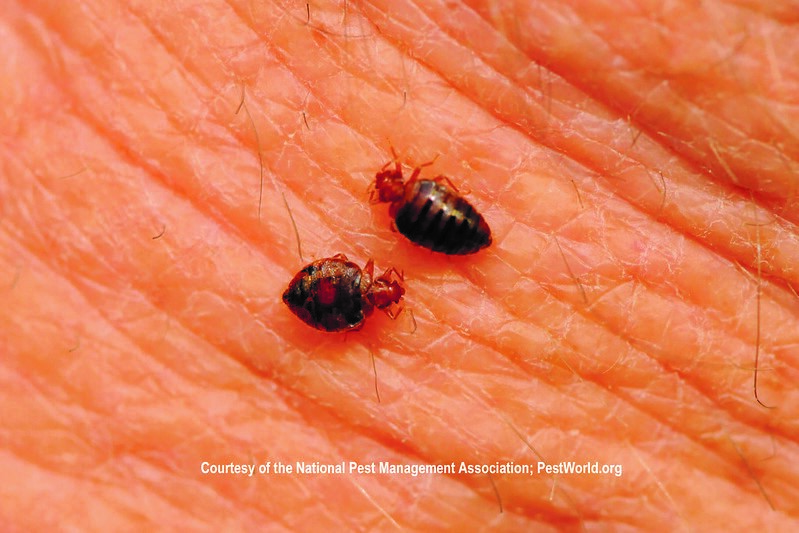Credit for feature photo: Flickr
Bed bugs are a homeowner’s worst nightmare. They hitch a ride on our luggage during travel and then sequester themselves in our homes until nightfall. Under the cover of darkness, they emerge to sink their straw-like noses into our flesh and slurp up our tasty blood, causing their flat, disk-like abdomen to balloon with our body fluids.

Most people want to avoid bed bugs and their irritating, potentially rash-causing bites, with perhaps one exception – forensic scientists. Dr. Khalid M. Lodhi, a forensics professor at Fayetteville University, and Dr. Coby Schal, an ecology and entomology professor at North Carolina State University, wondered if this blood-sucking pest could aid forensic investigation. Presently, forensic scientists can reliably extract DNA from blood and identify people based on their DNA profiles, but could we achieve the same with the blood “meal” found in a bed bug’s belly?
The two research labs tested their hypothesis by combining their individual expertise: Schal’s with insect behavior and Lodhi’s with forensic biology.The Schal lab fed bed bugs blood from either a female, a male, or a combination of the two. The bugs were then frozen in ethanol for transport from the Schal lab in Raleigh to the Lodhi lab in Fayetteville. Lodhi lab’s student researchers then ground the bugs into a paste and extracted the DNA from this mixture using the traditional phenol/chloroform/isoamyl alcohol method. Since the quantification and amplification method they used only worked for human DNA, they did not need to worry about any bed bug DNA interfering.
After analysis the researchers discovered they could extract nanogram quantities of human DNA from each bug immediately after feeding all the way to 4.5 days post-feeding—with the recovery amount decreasing over time (Fig 1). The greatest recovery from bugs fed female blood or male-bloo- peaked about 24 hours post-feeding, while the greatest recovery from bugs fed a female-male mixture was around 36 hours. Most importantly, the quantity of DNA recovered before 3.5 days was sufficient to obtain full DNA profiles for both the human male and female blood donors even in a mixture.

After this analysis Lodhi’s lab looked closer. DNA profiles currently consist of 13 STR loci. Loci are repeat strings of nucleotides located at specific spots on chromosomes. Forensic geneticists determine your unique combinations of the 13 different STR loci, which have variable repeat lengths and single nucleotide changes to create a statistically significant profile for an individual. One example of an STR loci is called D8S1179. This locus consists of repeats of TCTA and humans can have anywhere from 7 repeats to 20 of TCTA at this genetic location, with some single base switches in-between. Everyone inherits one version of an STR loci from each of their parents, which leads to an enormous number of combinations. This is a key reason why DNA fingerprinting with full profiles is so effective. The combination of all 13 STR loci used by forensic geneticists has the power to distinguish a single DNA profile from a Caucasian individual amidst a Caucasian population of 575 trillion!
The Lodhi lab investigated how each individual STR loci would be affected in a bed bug’s stomach. Would the longer STR loci be more difficult to identify properly? Were certain STR loci degrading at a faster rate than others leading to the incomplete and inaccurate profiles seen at the 4-day timepoint?
Lodhi’s student researchers monitored representatives of short, medium and long STR loci over the 4.5-day period and found that their greatest recovery of the longest marker peaked on the same days as the greatest recovery of total human blood. It was discovered that by day 3, they could no longer quantify the longest STR loci. This is in contrast, to the shortest loci marker, which was seen up to the 4th day, but at very low-quality. The hypothesis that the longer STR loci degraded faster than the shorter loci in the bed bug’s stomach proved to be correct.
These results demonstrate how useful and feasible recovering human DNA evidence from bed bugs is and helps to establish that the best results can be obtained within a three-day-post-feeding time window. There are several advantages that bed bugs have for forensic purposes as compared to other insects such as lice and mosquitos, which have also been investigated in this context. Bed bugs are wingless and normally reside close to their “feeding location” i.e. bed mattresses, couches and cushioned chairs. Although some populations of bed bugs have been known to travel extensively within and between apartment buildings, long-range movement outside a building is human driven rather than motivated by insect behavior. If a victim or suspect was near a bed bug-infested bed, forensic scientists could potentially find some pests with a tidy little DNA sample stored in their stomachs. Goodnight, sleep tight, and don’t let the bed bugs bite…unless it’s for forensic evidence!
| Title | Isolation, identification and time course of human DNA typing from bed bugs, Cimex lectularius |
| Authors | Coby Schal, Natalie Czado, Richard Gamble, Amy Barrett, Kiera Weathers, Khalid Mahmud Lodhi |
| Journal | Forensic Science International |
| Year | 2018 |
| Link | https://www.sciencedirect.com/science/article/pii/S0379073818309101 |
